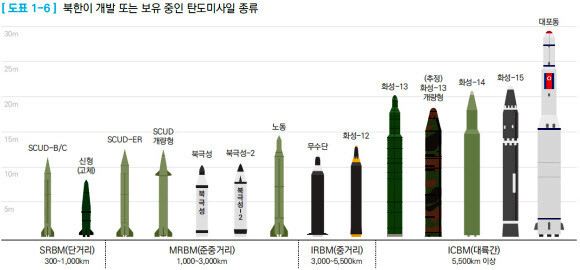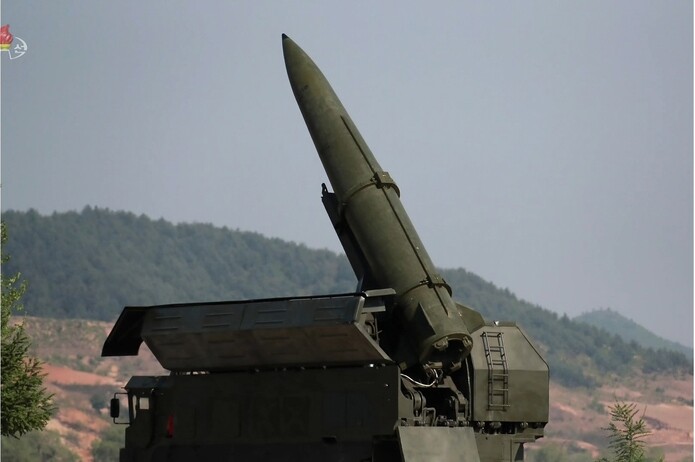hankyoreh
Links to other country sites 다른 나라 사이트 링크
Defense Ministry categorizes NK projectiles as “new ballistic missile using solid fuel”

A short-range missile similar in form to the ones test-launched by North Korea on May 4 and 9 has been categorized by the South Korean Ministry of National Defense (MND) as a “new ballistic missile using solid fuel,” it was confirmed on May 12. Many military experts are speculating the missiles were a model commonly referred to as the “North Korean Iskander.” But military officials reserved judgment on the matter, claiming that the two missile types were identical and calling for additional analysis of the flight characteristics, range, speed, and altitude to determine whether the recently launched missiles were ballistic missiles.
A section of the 2018 Defense White Paper published by MND in January about the strategic forces operating North Korea’s missiles includes a diagram and illustration categorizing 14 “ballistic missiles being developed or maintained by North Korea” according to range. In the diagram, the MND listed a similarly shaped missile to the ones recently test-launched by North Korea in the category of “short-range ballistic missiles” (300–1,000km) alongside the Scud-B and Scud-C. An explanation describes the missile as “new [solid fuel],” indicating that the missile is a different type from the Scud and uses solid fuel.

The new short-range ballistic missile shown in the Defense White Paper is similar in many ways to the missile in images published by North Korea the day after the launch. It has a ring supporting the missile midway along its body, with wings attached at the engine portion. Images released by North Korea showed the ring detaching as the missile blasts off its transporter erector launcher (TEL). The wings are also clearly visible. The missile in question is believed to use solid fuel.
The missile made its first public appearance at a military review for the 70th anniversary of the North Korean armed forces’ establishment on Feb. 8 of last year. Military experts believe it to be an upgraded version of Russia’s Iskander short-range surface-to-surface ballistic missile. The Iskander is known to be a difficult missile to intercept due to its complex flight trajectory, which includes a rapid descent from its peak altitude, followed by a horizontal flight pattern before dropping vertically over its target.
The missiles test-launched by North Korea are believed to have a maximum range of 500km. A launch from the front line near the Military Demarcation Line (MDL) would put the entire South Korean territory within range. The Iskander is also known to travel roughly the same distance, depending on the model and flight method. The latest missiles were reported to be roughly 7m, shorter than the Scud-B or Scud-C.
By Yoo Kang-moon, senior staff writer
Please direct comments or questions to [english@hani.co.kr]

Editorial・opinion
![[Editorial] Intensifying US-China rivalry means Seoul must address uncertainty with Beijing sooner than later [Editorial] Intensifying US-China rivalry means Seoul must address uncertainty with Beijing sooner than later](https://flexible.img.hani.co.kr/flexible/normal/500/300/imgdb/original/2024/0517/8117159322045222.jpg) [Editorial] Intensifying US-China rivalry means Seoul must address uncertainty with Beijing sooner than later
[Editorial] Intensifying US-China rivalry means Seoul must address uncertainty with Beijing sooner than later![[Column] When ‘fairness’ means hate and violence [Column] When ‘fairness’ means hate and violence](https://flexible.img.hani.co.kr/flexible/normal/500/300/imgdb/original/2024/0516/7417158465908824.jpg) [Column] When ‘fairness’ means hate and violence
[Column] When ‘fairness’ means hate and violence- [Editorial] Yoon must stop abusing authority to shield himself from investigation
- [Column] US troop withdrawal from Korea could be the Acheson Line all over
- [Column] How to win back readers who’ve turned to YouTube for news
- [Column] Welcome to the president’s pity party
- [Editorial] Korea must respond firmly to Japan’s attempt to usurp Line
- [Editorial] Transfers of prosecutors investigating Korea’s first lady send chilling message
- [Column] Will Seoul’s ties with Moscow really recover on their own?
- [Column] Samsung’s ‘lost decade’ and Lee Jae-yong’s mismatched chopsticks
Most viewed articles
- 1[Editorial] Transfers of prosecutors investigating Korea’s first lady send chilling message
- 2S. Korea “monitoring developments” after report of secret Chinese police station in Seoul
- 3[Exclusive] Unearthed memo suggests Gwangju Uprising missing may have been cremated
- 4[Editorial] Intensifying US-China rivalry means Seoul must address uncertainty with Beijing sooner t
- 5China, Russia put foot down on US moves in Asia, ratchet up solidarity with N. Korea
- 6Xi, Putin ‘oppose acts of military intimidation’ against N. Korea by US in joint statement
- 7Truth commission confirms Korean War killings by soldiers and police
- 8[Editorial] South Korean women are mobilizing in unprecedented ways
- 9Calls for gender-equality continue as demonstrations target President Moon
- 10[Column] “Hoesik” as ritual of hierarchical obedience